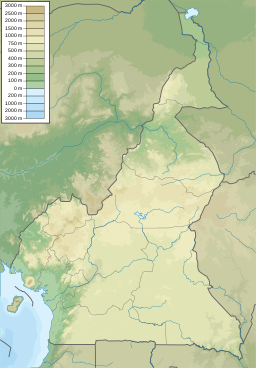| Lake Ossa | |
|---|---|
 | |
  | |
| Location | Littoral Province |
| Coordinates | 3°47′48″N 10°01′29″E / 3.796663°N 10.024779°E / 3.796663; 10.024779 |
| Catchment area | Sanaga River |
| Basin countries | Cameroon |
| Max. length | 7 km (4.3 mi) |
| Surface area | 39.27 km (15.16 sq mi) |

Lake Ossa is a lake that lies west of Edéa in the Littoral Province of Cameroon. Lake Ossa, together with the smaller lakes Mevia to the northeast and Mwembe to the southwest, form the Lake Ossa complex. The lake complex covers an area of 39.27 km, and is Cameroon's largest natural lake.
Geography
The lakes have a dissected shape, with numerous inlets and islands. Lake Ossa is 7 km (4.3 mi) wide at its widest point. The lakes are in the lower basin of the Sanaga River, and are linked to the river by a narrow channel 3 km (1.9 mi) in length. The lake complex was created by tectonic movements of the Earth's crust. The lake shores are often steep, sloping 70 to 80 meters above the surface of the lake.
Ecology
The lake complex is home to the African manatee (Trichechus senegalensis), dwarf crocodile (Osteolaemus tetraspis), African softshell turtle (Trionyx triunguis). The lakes have 36 species of fish, in 21 families – eight species of cichlids, six species of Mormyridae, three of Alestidae, and two of Claroteidae.
Lake Ossa's shores are forested with lowland rain forest, part of the Cross-Sanaga-Bioko coastal forests ecoregion. Common trees include azobe (Lophira alata), ndo’o (Irvingia gabonensis), African corkwood (Musanga cecropioides), afara (Terminalia superba) and iroko (Milicia excelsa). There is a freshwater swamp forest at the southeastern end of the lake around the outflow channel, with the trees Pandanus, Raphia, Mitragyna, and Uapaca.
People and economy
The largest town is Beach, southeast of the lake. There are several small villages around the lake shore.
The lake is an important source of fish, and supports a community of small-scale fish catchers and fish sellers who supply fish to Dizanguè and Edéa. Lake Ossa is a popular site for recreational fishing, boating, and watersports.
Lake Ossa Faunal Reserve
Lake Ossa Faunal Reserve (Réserve de Faune du Lac Ossa) covers an area of 45.39 km. The reserve was created on 2 December 1948 by Order No. 538 of the colonial government. The reserve's boundaries were clarified by Order No. 14-2 of 6 July 1974. The reserve is in IUCN category IV.
References
- ^ Olson, David & Ormeno Garcia, Santiago. (2017). Participatory Freshwater Conservation: Management guidelines for the Lake Ossa Wildlife Reserve in Cameroon.
- Neba, Aaron (1999). Modern Geography of the Republic of Cameroon, 3rd ed. Bamenda: Neba Publishers. p. 44
- West, Ben (2004). Cameroon: The Bradt Travel Guide. Guilford, Connecticut: The Globe Pequot Press Inc. p. 111
- "Lac Ossa". Protected Planet, Accessed 15 June 2020.